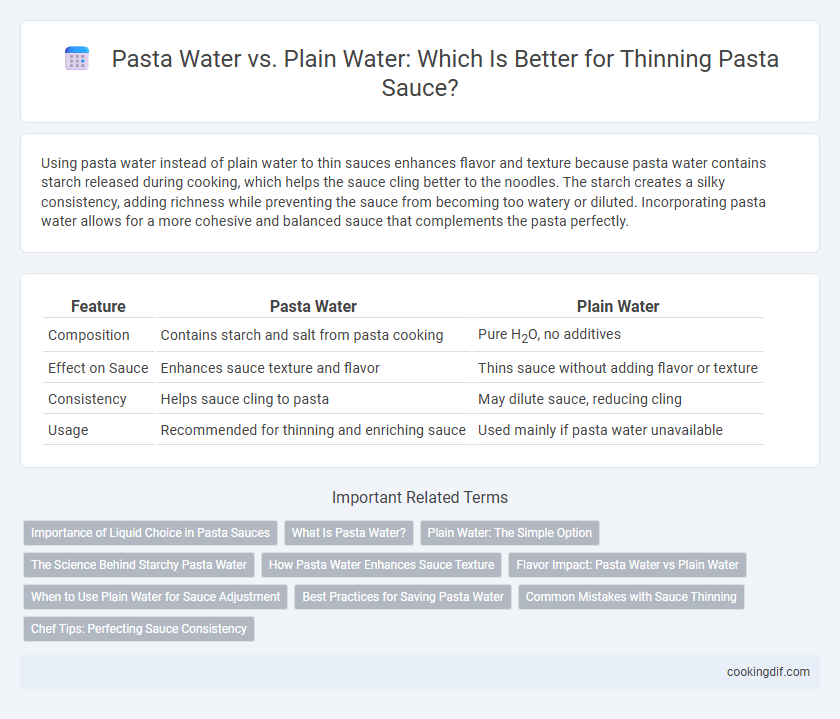Using pasta water instead of plain water to thin sauces enhances flavor and texture because pasta water contains starch released during cooking, which helps the sauce cling better to the noodles. The starch creates a silky consistency, adding richness while preventing the sauce from becoming too watery or diluted. Incorporating pasta water allows for a more cohesive and balanced sauce that complements the pasta perfectly.
Table of Comparison
| Feature | Pasta Water | Plain Water |
|---|---|---|
| Composition | Contains starch and salt from pasta cooking | Pure H2O, no additives |
| Effect on Sauce | Enhances sauce texture and flavor | Thins sauce without adding flavor or texture |
| Consistency | Helps sauce cling to pasta | May dilute sauce, reducing cling |
| Usage | Recommended for thinning and enriching sauce | Used mainly if pasta water unavailable |
Importance of Liquid Choice in Pasta Sauces
Pasta water contains starch released from the pasta during cooking, which acts as a natural thickener and emulsifier, helping sauces cling better to noodles compared to plain water. The presence of these starches enhances sauce texture and flavor integration, preventing separation and creating a silky consistency. Choosing pasta water over plain water is essential for achieving professional-quality sauce balance and mouthfeel in pasta dishes.
What Is Pasta Water?
Pasta water is the starchy, salted water leftover from boiling pasta that contains dissolved starch released by the pasta during cooking. It is often used to thin and emulsify pasta sauces, helping them cling better to the noodles by creating a smoother, silkier texture. Unlike plain water, pasta water enhances sauce flavor and consistency due to its unique composition of starch and seasoning.
Plain Water: The Simple Option
Plain water offers a straightforward method for thinning pasta sauce without altering its flavor profile or texture. It maintains the sauce's original consistency while allowing precise control over thickness, making it ideal for delicate or lightly seasoned dishes. Using plain water ensures no additional starch or salt content, preserving the sauce's intended taste and preventing unwanted dilution.
The Science Behind Starchy Pasta Water
Starchy pasta water contains dissolved amylose and amylopectin molecules released from the pasta during cooking, which act as natural emulsifiers and thickeners in sauce thinning. These starches bind with fat molecules in the sauce, creating a smoother, creamier texture and helping the sauce adhere better to the pasta strands. Using plain water lacks these starch compounds, resulting in a thinner sauce that may separate or slide off the pasta more easily.
How Pasta Water Enhances Sauce Texture
Pasta water contains starch released during cooking, which acts as a natural thickener and emulsifier, improving sauce texture and consistency. The starch molecules bind with the sauce ingredients, creating a velvety, cohesive blend that clings better to pasta. Unlike plain water, pasta water enhances sauce creaminess and depth without diluting flavors, making it essential for perfecting many Italian dishes.
Flavor Impact: Pasta Water vs Plain Water
Pasta water contains starch released from the pasta during cooking, enriching sauces with a silky texture and enhanced flavor compared to plain water. The starch acts as a natural thickener, helping the sauce cling better to the pasta and intensifying the overall taste profile. Using pasta water preserves the savory, slightly salty essence, whereas plain water can dilute the sauce's flavor and consistency.
When to Use Plain Water for Sauce Adjustment
Plain water is ideal for thinning sauces when a lighter texture and more neutral flavor are desired, especially in delicate dishes like tomato or cream-based sauces. It prevents overpowering the sauce's original taste and avoids adding extra starch, which can alter consistency. Use plain water cautiously to maintain sauce balance without diluting its depth or richness.
Best Practices for Saving Pasta Water
Saving pasta water is essential for perfecting sauce consistency due to its high starch content that helps bind and thicken sauces. Use a heatproof container to reserve at least one cup of pasta water before draining, ensuring you have enough liquid to adjust the sauce texture without diluting the flavor. For best results, add the pasta water gradually while stirring the sauce to achieve a silky, cohesive finish.
Common Mistakes with Sauce Thinning
Using plain water instead of pasta water for sauce thinning often leads to a lack of flavor and improper sauce consistency. Pasta water contains starch released during cooking, which helps emulsify and thicken the sauce while enhancing its texture and mouthfeel. A common mistake is overusing pasta water, causing the sauce to become too watery instead of achieving the ideal silky finish.
Chef Tips: Perfecting Sauce Consistency
Using pasta water instead of plain water to thin sauces leverages the starchy content, which enhances sauce adhesion and texture. The residual starch in pasta water creates a silkier, more cohesive sauce that clings better to noodles, preventing separation. Chefs recommend reserving about a cup of pasta water before draining to adjust sauce consistency dynamically during cooking.
Pasta water vs plain water for sauce thinning Infographic

 cookingdif.com
cookingdif.com